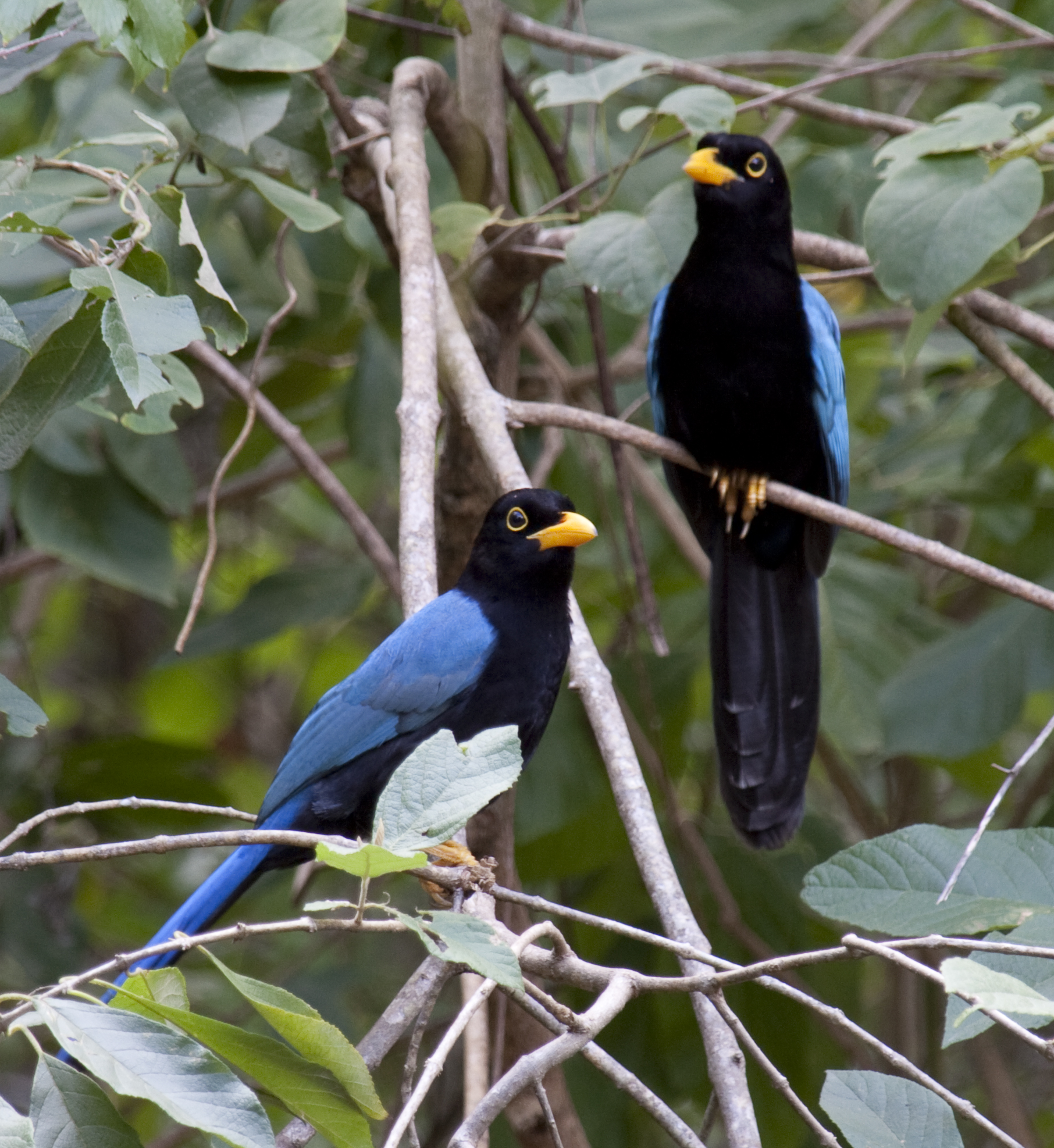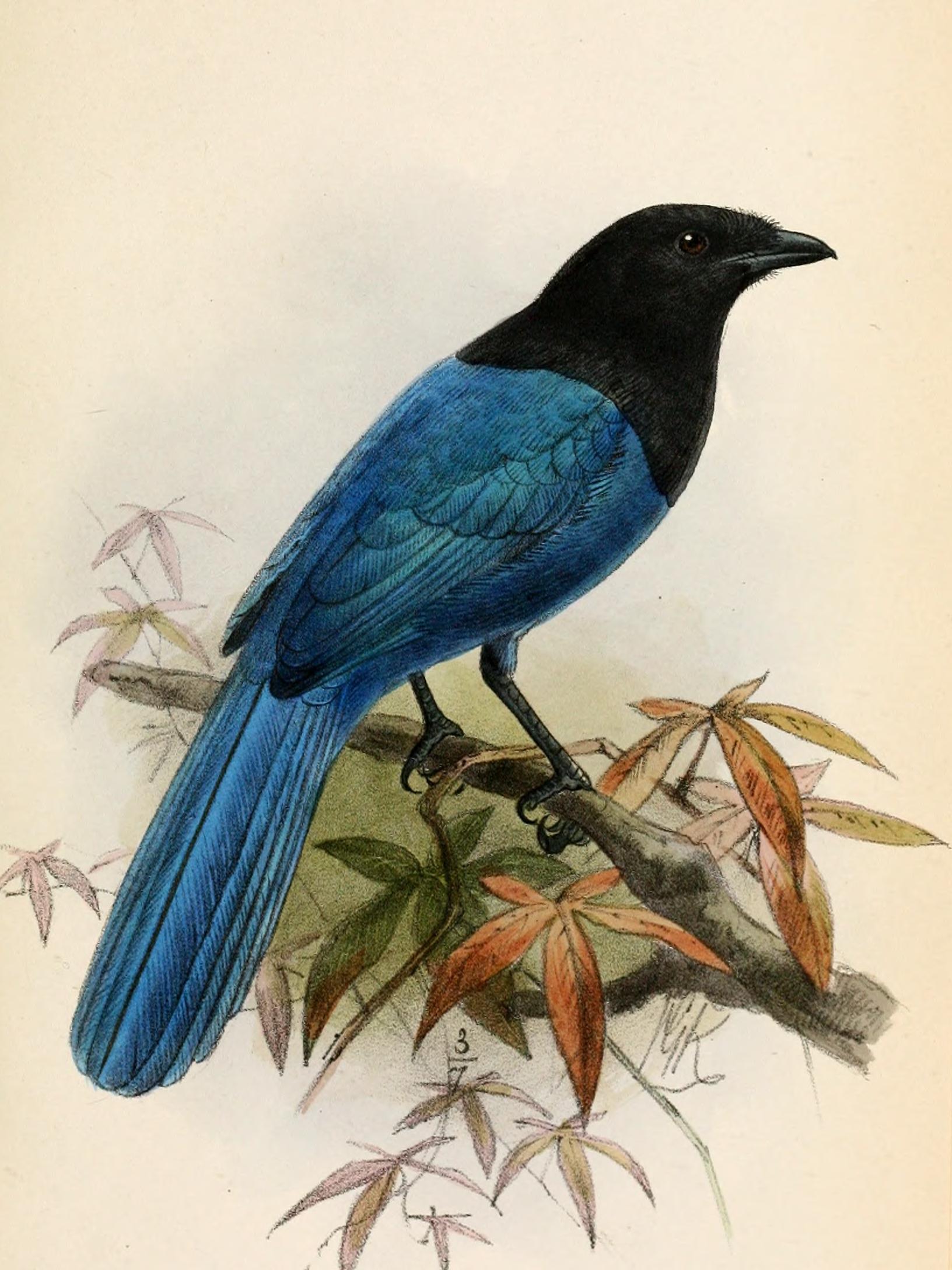|
Cyanocorax
''Cyanocorax'' is a genus of New World jays, passerine birds in the family Corvidae. The generic name is derived from the Greek words ╬║Žģ╬▒╬Į╬┐Žé (''kuanos''), meaning "dark blue," and ╬║╬┐Žü╬▒╬Š (''korax''), meaning "raven". It contains several closely related species that primarily are found in wooded habitats of Mexico and Central and South America, with the green jay just barely entering the United States. The genus ''Cyanocorax'' was introduced by the German zoologist Friedrich Boie in 1826, with the plush-crested jay as the type species. Species The genus contains 17 species: Some ornithologists treat the green jay and the Inca jay as conspecific Biological specificity is the tendency of a characteristic such as a behavior or a biochemical variation to occur in a particular species. Biochemist Linus Pauling stated that "Biological specificity is the set of characteristics of living organ ..., with ''C. yncas luxuosus'' as the green jay and ''C. yncas yncas'' as ... [...More Info...] [...Related Items...] OR: [Wikipedia] [Google] [Baidu] |
Corvidae
Corvidae is a cosmopolitan family of oscine passerine birds that contains the crows, ravens, rooks, jackdaws, jays, magpies, treepies, choughs, and nutcrackers. In colloquial English, they are known as the crow family or corvids. Currently, 133 species are included in this family. The genus '' Corvus'', including the crows, rooks, and ravens, makes up over a third of the entire family. Corvids ( ravens) are the largest passerines. Corvids display remarkable intelligence for animals of their size, and are among the most intelligent birds thus far studied. Specifically, members of the family have demonstrated self-awareness in mirror tests ( European magpies) and tool-making ability (e.g. crows and rooks), skills which until recently were thought to be possessed only by humans and a few other higher mammals. Their total brain-to-body mass ratio is equal to that of non-human great apes and cetaceans, and only slightly lower than that of humans.Birding in India and ... [...More Info...] [...Related Items...] OR: [Wikipedia] [Google] [Baidu] |
Green Jay
The green jay (''Cyanocorax luxuosus'') is a species of the New World jays, and is found in Central America. Adults are about long and variable in colour across their range; they usually have blue and black heads, green wings and mantle, bluish-green tails, black bills, yellow or brown eye rings, and dark legs. The basic diet consists of arthropods, vertebrates, seeds, and fruit. The nest is usually built in a thorny bush; the female incubates the clutch of three to five eggs. This is a common species of jay with a wide range and the International Union for Conservation of Nature has rated its conservation status as being of "least concern". Taxonomy Some ornithologists treat the green jay as conspecific with the Inca jay of the Andes, with ''C. yncas luxuosus'' as the green jay and ''C. yncas yncas'' as the Inca jay. Description Green jays are in length. Weight ranges from . They have feathers of yellowish-white with blue tips on the top of the head, cheeks and nape, though ... [...More Info...] [...Related Items...] OR: [Wikipedia] [Google] [Baidu] |
Yucatan Jay
The Yucatan jay (''Cyanocorax yucatanicus'') is a species of bird in the family Corvidae, the crows and their allies. It is native to the Yucat├Īn Peninsula where its habitats are subtropical or tropical dry forest, plantations and cleared areas at altitudes up to . Adults are about long, black, with blue wings, mantle, and tail, black bills, yellow eye rings and legs. Immature birds have yellow bills. This is a common species of jay with a wide range and the International Union for Conservation of Nature has rated its conservation status as being of "least concern". Range and habitat It is found primarily in the Yucat├Īn Peninsula, which comprises the northern part of the nation of Belize; and Guatemala's northern El Pet├®n Department and the Mexican states of Yucat├Īn, Quintana Roo and Campeche. It is also present in parts of the neighbouring states of Chiapas and Tabasco. Its natural habitats are subtropical or tropical dry forests, heavily degraded former forest, and plantat ... [...More Info...] [...Related Items...] OR: [Wikipedia] [Google] [Baidu] |
Azure Jay
The azure jay (''Cyanocorax caeruleus'') (Brazilian Portuguese: ''Gralha-azul'', meaning ''blue jackdaw'') is a passeriform bird of the crow family, Corvidae. It is found in the Atlantic Forest, especially with ''Araucaria angustifolia'', in south-eastern Brazil (S├Żo Paulo to Rio Grande do Sul), far eastern Paraguay and far north-eastern Argentina. It is the state bird of Paran├Ī. Description The azure jay has a total length of approximately and it weighs about , and is the largest South American corvid. Its plumage is intensely blue with a contrasting black head and upper chest. Males and females are similar, although the females typically are smaller. Its breeding season is from October to January. This bird is a social breeder. It lays 2ŌĆō4 eggs and its nest is made of sticks. It is placed above the ground in an Araucaria tree. Diet It feeds extensively on the nut-like seeds of ''Araucaria angustifolia'', but it is not strictly limited to this since it also feeds o ... [...More Info...] [...Related Items...] OR: [Wikipedia] [Google] [Baidu] |
Plush-crested Jay
The plush-crested jay (''Cyanocorax chrysops'') is a jay of the family Corvidae (which includes the crows and their many allies). It is found in central-southern South America: in southwestern Brazil, Bolivia, Paraguay, Uruguay, and northeastern Argentina, including southern regions of the Amazon Basin river systems bordering the Pantanal. Description It is an elegant medium-sized bird, dark plumaged with a cream-yellow breast; the bulky tail is also cream colored, top and underneath, for the lower half. Distribution The range of the plush-crested jay extends from the Southern Region, Brazil with Uruguay and approaches the South Atlantic coast, but avoids the coast, approximating a 400 to 150 km coastal strip; the coastal-inland range extends 3500 km from S├Żo Paulo south to Rio Grande do Sul bordering Uruguay. The inland range continues in northwestern Uruguay and extends northwest through northern Argentina, ParaguayŌĆōBolivia, and through the Pantanal at the sout ... [...More Info...] [...Related Items...] OR: [Wikipedia] [Google] [Baidu] |
Cyanocorax Cayanus
The Cayenne jay (''Cyanocorax cayanus'') is a species of bird in the family Corvidae. It is found in Brazil, French Guiana, Guyana, Suriname, and Venezuela. Its natural habitats are subtropical or tropical moist lowland forest, subtropical or tropical dry shrubland, and heavily degraded former forest. In 1760 the French zoologist Mathurin Jacques Brisson included a description of the Cayenne jay in his ''Ornithologie'' based on a specimen collected in Cayenne, French Guiana. He used the French name ''Le geay de Cayenne'' and the Latin ''Garrulus Cayanensis''. The two stars (**) at the start of the section indicates that Brisson based his description on the examination of a specimen. Although Brisson coined Latin names, these do not conform to the binomial system and are not recognised by the International Commission on Zoological Nomenclature. When in 1766 the Swedish naturalist Carl Linnaeus updated his ''Systema Naturae'' for the twelfth edition, he added 240 species that had ... [...More Info...] [...Related Items...] OR: [Wikipedia] [Google] [Baidu] |
Purplish-backed Jay
The purplish-backed jay (''Cyanocorax beecheii'') is a bird of the crow family Corvidae, with purple feathers on its back, wings and tail, and black feathers elsewhere. It is endemic to northwestern Mexico where its habitat is mainly dry deciduous forest. The International Union for Conservation of Nature has assessed it as being a "species of least concern". Description The purplish-backed jay is a purple and black bird with a powerful bill and a long tail. It varies in length between with males usually larger than females. The head, neck, upper mantle and underparts are black, and there is a small ruffled, erectile crest on the forehead. The underside of the wings and the tail are also blackish, while the remainder of the plumage is purplish-blue, being brightest on the lower part of the mantle and the rump. The bill is black and the irises and legs are yellow. Ecology This jay forms small social groups consisting of an adult pair and up to three young from the previous year ... [...More Info...] [...Related Items...] OR: [Wikipedia] [Google] [Baidu] |
Bushy-crested Jay
The bushy-crested jay (''Cyanocorax melanocyaneus'') is a species of bird in the family Corvidae. It is found in Central America, where its natural habitats are subtropical or tropical moist montane forests and heavily degraded former forest. There are two subspecies, ''C. m. melanocyaneus'' which is found in Guatemala and southern El Salvador, and ''C. m. chavezi'' from Honduras and northeastern Nicaragua. Description The adult bushy-crested jay has a length of . The tail is long and the central feathers are graduated. The sexes look alike; the head, neck, breast and upper mantle are black while the remaining upper parts are dark blue with a sheen of green or violet. The underparts are plain greenish-blue, the undersides of the wings are grey and the underside of the tail is blackish. The head bears a stubble-like erectile crown of feathers, the beak is black and relatively small, the irises are yellow and the legs black. Distribution and habitat This jay is native to Centr ... [...More Info...] [...Related Items...] OR: [Wikipedia] [Google] [Baidu] |
Plush-crested Jay
The plush-crested jay (''Cyanocorax chrysops'') is a jay of the family Corvidae (which includes the crows and their many allies). It is found in central-southern South America: in southwestern Brazil, Bolivia, Paraguay, Uruguay, and northeastern Argentina, including southern regions of the Amazon Basin river systems bordering the Pantanal. Description It is an elegant medium-sized bird, dark plumaged with a cream-yellow breast; the bulky tail is also cream colored, top and underneath, for the lower half. Distribution The range of the plush-crested jay extends from the Southern Region, Brazil with Uruguay and approaches the South Atlantic coast, but avoids the coast, approximating a 400 to 150 km coastal strip; the coastal-inland range extends 3500 km from S├Żo Paulo south to Rio Grande do Sul bordering Uruguay. The inland range continues in northwestern Uruguay and extends northwest through northern Argentina, ParaguayŌĆōBolivia, and through the Pantanal at the sout ... [...More Info...] [...Related Items...] OR: [Wikipedia] [Google] [Baidu] |
Violaceous Jay
The violaceous jay (''Cyanocorax violaceus'') is a species of bird in the family Corvidae, the crows and their allies. It is found in Bolivia, Brazil, Colombia, Ecuador, Guyana, Peru, and Venezuela. Its natural habitats are subtropical or tropical moist lowland forests and heavily degraded former forest. This species is mainly a lowland bird although locally this jay may variously range to elevations as high as 500ŌĆō1,400 m. Description This is a medium-large jay with dull violet-blue plumage and a striking dark face and throat. The purplish jay (with which it overlaps in southeastern Peru and in northern Bolivia) is duller (more purplish or brownish blue, less violaceous blue) and the nape is not paler than the back. In eastern Colombia and southern Venezuela, the azure-naped jay is distinguished by its pale iris, white undertail coverts and tip to the tail, paler nape, and short frontal crest. The violaceous jay is long and weighs .) Behavior The violaceous jay is omni ... [...More Info...] [...Related Items...] OR: [Wikipedia] [Google] [Baidu] |




